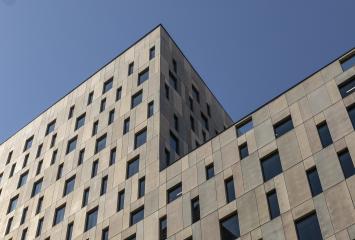Sourcing more than 70% green energy: commitment number 6 of Colonial's Decalogue of Sustainability
The production of energy usually entails inevitable environmental pollution. That is why at Colonial we established the reduction of energy consumption as commitment number one of our Sustainability Decalogue. However, this "usually leads" is important because there are certain sources of energy production that do not pollute: the so-called green energies or renewable energies. In this regard, obtaining more than 70% of the energy consumed in our buildings from green sources is the sixth of the commitments in the Decalogue. Real protection of the planet depends on this clean energy.
Measures adopted to obtain 70% green energy
The fundamental step towards achieving this objective, set for 2030, consisted of analyzing the current state and the entire set of characteristics of each asset individually to assess the possibilities of implementing renewable energies. This has been done on newly built assets, of course, but also on acquired assets subsequently subject to the process of rehabilitation and refurbishment. Step two, once the opportunities had been identified, was to invest in those green technologies that lead to more sustainable resource availability.
These technologies include photovoltaic panels, other photovoltaic structures, rooftop solar thermal systems and wind turbine systems for wind energy production. In some office buildings it was possible and advisable to opt for some solutions. In others, it was possible and advisable to opt for others. That is why the analysis phase is so important. Currently, and to speak of one of these technologies, our group has on-site solar photovoltaic installations on several of its most important assets, with an accumulated power of approximately 179 kWp. This independence in energy production is crucial.
However, while retrofitting to install endogenous clean energy production systems is taking place, we are pursuing and promoting another policy related to this commitment: the purchase of green energy. Based on the premise that many buildings are not yet autonomous in energy generation and that we must go outside to obtain this energy, we made the firm decision, in line with the ecological values of our group, to turn to green producers. It is through these two complementary strategies that we have managed to approach year after year our commitment of 70% green energy consumption.
Colonial's current status on green energy procurement
Colonial set its goal of 70% renewable energy procurement by 2018. Then, at the outset, the percentage of green sourced energy was 0%. Two years later, in 2020 and after a pandemic that hampered the implementation of measures, it rose to 62%. We were very close. Already in 2021, we reached the target. This is the same phenomenon that occurred with other commitments in our Decalogue: we reached it much earlier than planned. In response, and given our sense of responsibility, we have continued to work to further increase this percentage. We are strengthening our active role in the fight against climate change.
Buildings in Colonial's catalog that exemplify this principle
First of all, it is worth pausing for a moment to look at the big picture. In Madrid and Barcelona, the two cities where the group is present through numerous office buildings, renewable energy procurement amounted to 89% in 2021. In Paris, where the group has grown strongly in recent years, the percentage amounts to 46%, but with the conviction that the measures taken from now on will continue to increase it until the targets are reached. At Biome, for example, one of Colonial's key buildings in the French capital, photovoltaic technologies will be installed by 2022.
At Wittywood, a hallmark of sustainability in Barcelona, there has been an 11% reduction in non-renewable energy consumption, giving a further degree of environmental friendliness to an already extremely green office building. Illacuna, also located in Barcelona, has a photovoltaic solar energy installation with an annual output of 36,000 kilowatt hours. Clean energy production technologies only generate pollution at the time of manufacture due to the extraction of materials, but they generate long-term sustainability. And that is where we are looking: to the future.

